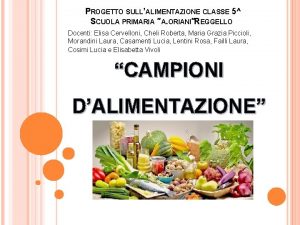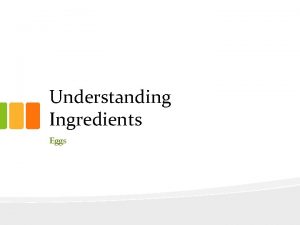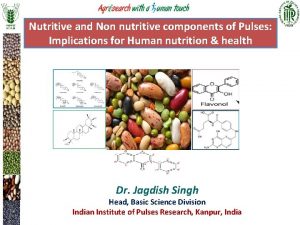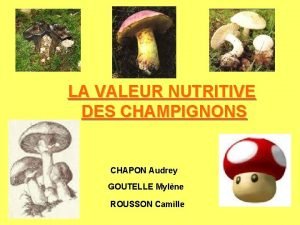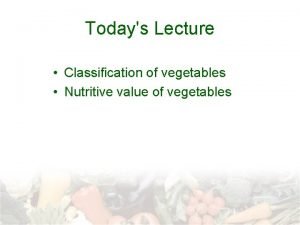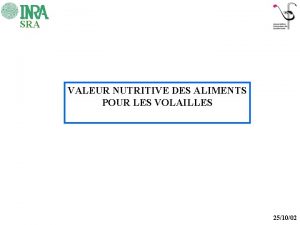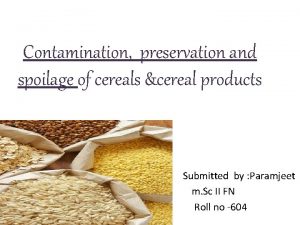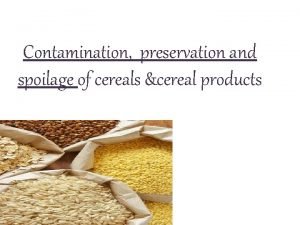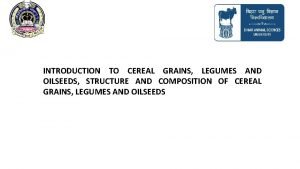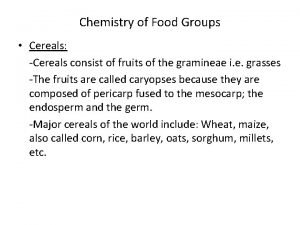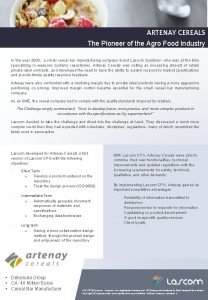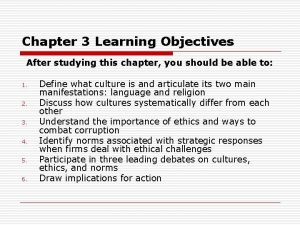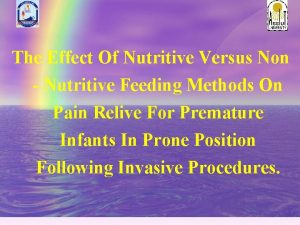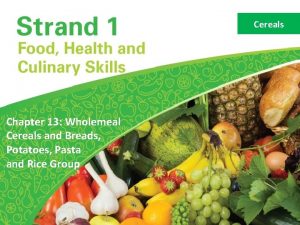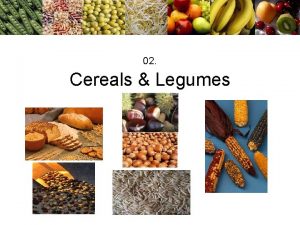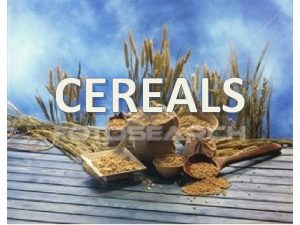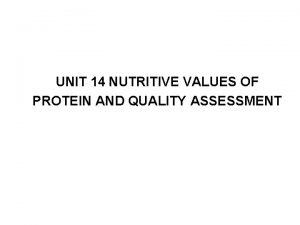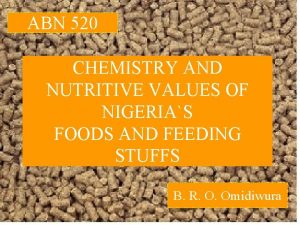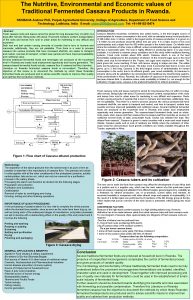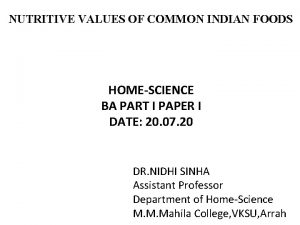Processing of cereals Cerealstypes nutritive values and uses




































- Slides: 36

Processing of cereals

Cereals-types, nutritive values and uses • Cereals, or grains, are members of the grass family cultivated primarily for their starchy seeds (technically, dry fruits). • Wheat, rice, corn (maize), rye, oats, barley, sorghum, and some of the millets are common cereals • Nutritional composition of some cereals are provided below

Nutritional composition of selected cereal grains

Wheat • The three principal types of wheat used in modern food production are Triticum vulgare (or aestivum), T. durum, and T. compactum. • T. vulgare provides the bulk of the wheat used to produce flour for bread making and for cakes and biscuits (cookies). • It can be grown under a wide range of climatic conditions and soils. • T. durum, longer and narrower in shape than T. vulgare, is mainly ground into semolina (purified middlings) instead of flour. • Durum semolina is generally the best type for the production of pasta foods. • T. compactum is more suitable for confectionery and biscuits than for other purposes.

• The wheat grain, the raw material of flour production and the seed planted to produce new plants, consists of three major portions: • (1) the embryo or germ (including its sheaf, the scutellum) that produces the new plant, • (2) the starchy endosperm, which serves as food for the germinating seed and forms the raw material of flour manufacture, and • (3) various covering layers protecting the grain. • Average wheat grain composition is approximately 85 percent endosperm, 13 percent husk, and 2 percent embryo.

Wheat structure

Wheat structure

Barley • Most of the barley grown in the world is used for animal feed, but a special pure barley is the source of malt for beer production. • Barley is also used in the manufacture of vinegar, malt extract, some milk-type beverages, and certain breakfast foods. • In addition, in flaked form it is employed in some sections of the brewing industry, and pearl barley (skins removed by emery friction) is used in various cooked foods. • Barley can be cultivated on poorer soil and at lower temperatures than wheat. • An important characteristic in barley is “winterhardiness, ” which involves the ability to modify or withstand many types of stresses, particularly that of frost. • However, barley is subject to many of the diseases and pests that affect wheat.

• The use of barley in animal feed is increasing; it has been a basic ingredient of pig foods for years and is increasingly used for cattle feed. • Its use in poultry foods has decreased because it has a lower starch equivalent when compared with wheat or corn and thus provides a lower-energy ration, unsuitable in modern poultry production. • Barley vitamin content is similar to that of wheat.


Corn • Corn, or maize, a cereal cultivated in most warm areas of the world, has many varieties. • The plant grows to a height of about three metres or more. • The corn kernel is large for a cereal, with a high embryo content, and corn oil extracted from the germ is commercially valuable. • The microscopic appearance of the starch is distinctive, and the principal protein in ordinary corn is the prolamin zein, constituting half of the total protein. • On hydrolysis zein yields only very small amounts of tryptophan or lysine, making it low in biological value. • The proteins of corn, like those of most cereals other than wheat, do not provide an elastic gluten.

• Much of the corn is wet-processed to produce corn flour, widely used in cooking. • Corn, dry-milled as grits or as meal or turned into flaked corn with some of its starch partially gelatinized, is a popular component in compounded animal feedstuffs. • In dry-milled form it is also the basis of human food throughout large areas of Africa and South America. • Its nutritive value is limited by its low lysine content. • Much recent research has involved development of a corn with higher lysine content. • Mutants have been produced containing much less zein but possessing protein with higher than normal lysine and tryptophan contents, sometimes increased as high as 50 percent. • These corns, called Opaque-2 and Floury-2, possess certain drawbacks. They are generally lower in yield than dent hybrids, are subject to more kernel damage when combine-harvested, and may be more difficult to process. • Nevertheless, these new hybrid corns are expected to become widely cultivated, and the principles involved in their production may also be applied to sorghum, wheat, and rice. • Corn is popular for use in breakfast foods.


Sorghum • Sorghum, also called milo, is of smaller size than corn but is generally the same type of cereal, with similar appearance. • Its numerous types are mainly used for animal feeding. • It is grown extensively in the United States, Pakistan, central India, Africa, and China. • In the sorghum endosperm, the proteins soluble in hot 60 % alcohol, called kafirin, constitute the major portion of the protein. • Milo germ oil is similar to corn germ oil; its major fatty acids are palmitic, stearic, and particularly oleic and linoleic. • Milo is commercially graded in the United States. • In waxy varieties the starch is principally in the form of amylopectin, with very little amylose. • Such starches possess special viscosity characteristics.


Oats • Oats belong to the botanical genus Avena, which includes a large number of types, the principal being A. sativa, A. sterilis and A. strigosa. • Oats are widely grown in most countries • Oats are frequently grown on farms as feed for the farm’s livestock. • They are well balanced chemically, with fairly high fat content, and are particularly suitable for feeding horses and sheep. • Although a large portion of the world’s oat production is used for animal feed, oatmeal is a popular human food in many countries. • Thin-skinned grains, fairly rich in protein and not too starchy, are selected. • After cleaning, the oats are then kilned (roasted).


Rice • Cultivated rice is known botanically as Oryza sativa, only one of some 25 species comprising the genus Oryza. • Rice is the staple food for millions in Southeast Asia, almost equal to wheat in importance among the world’s cereal crops. • More than 90 percent of the world’s rice is grown in Asia, principally in China, India, Indonesia, and Bangladesh, with smaller amounts grown in Japan, Pakistan, and various Southeast Asian nations. • Rice is also cultivated in parts of Europe, in North and South America, and in Australia. • The bulk of the rice cultivated in Asia is grown under water in flooded fields. • Successful production depends on adequate irrigation, including construction of dams and waterwheels, and on the quality of the soil. • Long periods of sunshine are essential. • Rice yields vary considerably, ranging from 700 to 4, 000 kilograms per hectare (600 to 3, 500 pounds per acre). • Adequate irrigation, which means inundation of the fields to a depth of several inches during the greater part of the growing season, is a basic requirement for productive land use.

• As with other cereals, weeds are a constant problem. • The commonest pests include plant bugs, stem borers, worms, and grasshoppers. • The crop, often harvested with a sickle, is frequently dried in earth or concrete pits. • Threshing is often carried out by trampling or with crude implements. • Only in a few rice-growing regions are modern procedures used in harvesting.


Processing of Cereals • Cereals undergo a number of processing stages between harvest and consumption. • The first is the preparation of harvested grain for storage. • The second, which is referred to as primary processing, involves further treatment of the grain to clean it, sort, remove the husk and other inedible fractions from the grains or reduce the size. • The products from primary processing are still not consumable. • Primary processing of cereals includes cleaning, grading, hulling, milling, pounding, grinding, tempering, parboiling, soaking, drying, sieving.

Secondary processing • The third stage (secondary processing) transforms the grains into edible products. • Secondary processing of cereals (or 'adding value' to cereals) is the utilisation of the primary products (whole grains, flakes or flour) to make more interesting products and add variety to the diet. • Secondary processing of cereals includes the following processes: fermentation, baking, puffing, flaking, frying and extrusion.


Harvesting • There is an optimum time for harvesting cereals, depending on the maturity of the crop and the climatic conditions. This has a significant effect on the quality of the grain during storage. • Grain not fully ripened contains a higher proportion of moisture and will deteriorate more quickly than mature grains because the enzyme systems are still active. • If the grain remains in the field after maturing, it may spoil through wetting caused by morning dew and rain showers. There is also an increased risk of insect damage. • Cereals are traditionally harvested manually. There are three main types of harvesting equipment for the small scale producer: manual, animal powered and engine powered. • Harvested crops are left in the field for a few days to dry before further processing.

Threshing • Threshing is the removal of grains from the rest of the plant. It involves three different operations: 1. Separating the grain from the panicle 2. Sorting the grain from the straw 3. Winnowing the chaff from the grain. • A range of engine powered threshers are available.

Winnowing • Winnowing is the separation of the grains from the chaff or straw. • It is traditionally carried out by lifting and tossing the threshed material so that the lighter chaff and straw get blown to one side while the heavier seeds fall down vertically. • Hand-held winnowing baskets are used to shake the seeds to separate out the dirt and chaff. • They are very effective, but slow. • There is a range of winnowing machines that use a fan to create artificial wind. This speeds up the winnowing process. • Some of these contains sieves and screens that grade the grains as well.

Drying • Prior to storage or further processing, cereal grains need to be dried. • The most cost-effective method is to spread out in the sun to dry. • In humid climates it may be necessary to use an artificial dryer. • Simple grain dryers can be made from a large rectangular box or tray with a perforated base. The grain is spread over the base of the box and hot air is blown up through a lower chamber by a fan. • The fan can be powered by diesel or electricity and the heat supplied by kerosene, electricity, gas. • Cereal grains should be dried to 10 -15% moisture before storage.

Storage • Dried grains are stored in bulk until required for processing. • The grains should be inspected regularly for signs of spoilage and the moisture content tested. • If the grain has picked up moisture it should be re-dried. • Grains are often protected with insecticides and must be stored in rodent-proof containers.

Primary processing

Cleaning • Before further processing, grains are cleaned and graded according to size. • Winnowing machines can be used to separate out the chaff, soil and dirt. • Some machines have integral sieves that combine cleaning with grading.

Hulling • Several grains have an unpalatable husk or shell that needs to be removed by a decorticator. • A range of specialized machines are available for this task. A range of small rice hullers (both manual and powered) is available. • Less rice is broken during hulling if the rice is parboiled first. Rice polishers are available for removing the rice bran after hulling.

Pounding/Milling • Three main types of grain mill are available: Plate mill; Hammer mill; Roller mill. • The choice of mill depends on the raw material and the scale of production. Most grains can be ground in a hammer mill. • Plate mills are widely available in West Africa. The plate mill is derived from the stone mill. • Two chilled iron plates are mounted on a horizontal axis so that one of the plates rotates and • the grain is ground between them. The pressure between the two plates governs the fineness of the product and is adjusted by a hand screw. • There are manual versions of the plate mill available, though they are arduous and hard work to use. • Hammer mills are almost universally used throughout the developing world. They consist of a circular chamber in which beaters whirl at a high speed. • Roller mills are not used at the small scale because of their high cost and maintenance requirements.

Pounding /Milling • The milled grain is filtered out through a perforated plate that runs around the edge of the mill chamber. • The size of the holes in the perforated plate determines the fineness of grinding of the particles. • Grain for human food is ground to a finer particle size than animal food. • Hammer mills cannot be used for wet milling. • Roller mills crush the grains rather than milling them into smaller particles. Roller mills are usually used for animal food. • It is important to ensure that the grains have the optimum moisture content before milling. If the grain is too dry and hard, it is difficult to break down and requires more energy to convert it into flour. If the grain is too moist, the material sticks to the mill. • The optimum moisture content varies between cereal types and with the particular mill being used. • Dry grain can be conditioned by soaking in water. Moist grain can be dried before grinding. • Different cereal grains have different milling and grinding requirements.

Parboiling • Parboiling rice is an optional step, but one that improves the quality of hulling as it results in fewer broken grains. • About 50% of all rice grown is parboiled. • Parboiling involves soaking and heating the rice which pre-cooks the grains, loosens the hull, sterilizes and preserves the rice. • At the village level, parboiling is carried out in large pans over an open fire. • Rice parboilers, that improve the efficiency of cooking, are available.

Drying • The main reason for drying a food is to extend its shelf life beyond that of the fresh material, without the need for refrigerated transport and storage. • This goal is achieved by reducing the available moisture, or water activity to a level which inhibits the growth and development of spoilage and pathogenic microorganisms, reducing the activity of enzymes and the rate at which undesirable chemical changes occur. • Drying also reduces the weight of the food product. Shrinkage, which occurs often during drying, reduces the volume of the product. • These changes in weight and volume can lead to substantial savings in transport and storage costs and, in some cases, the costs of packaging.

SECONDARY PROCESSING
 Uses of cereals
Uses of cereals Secondary food processing
Secondary food processing Uda educazione alimentare scuola primaria classe prima
Uda educazione alimentare scuola primaria classe prima Valoarea energetica
Valoarea energetica Nutritive value of egg
Nutritive value of egg Production subsystem
Production subsystem What are phytochemicals
What are phytochemicals Non nutritive components of food
Non nutritive components of food Champignon valeur nutritive
Champignon valeur nutritive Lecture vegetable
Lecture vegetable Au coq valeur nutritive
Au coq valeur nutritive Spoilage of cereals
Spoilage of cereals Preservation of cereals
Preservation of cereals Structure of cereals
Structure of cereals Grains and cereals food group
Grains and cereals food group Bruce maglino workplace values
Bruce maglino workplace values Instrumental values
Instrumental values Artenay cereals
Artenay cereals Western values vs eastern values
Western values vs eastern values A bit can have two values
A bit can have two values What is human values definition
What is human values definition Unsharp masking matlab
Unsharp masking matlab Secondary processing meaning
Secondary processing meaning What is interactive processing
What is interactive processing Top-down processing
Top-down processing Gloria suarez
Gloria suarez Bottom up and top down processing
Bottom up and top down processing Image enhancement by point processing
Image enhancement by point processing Histogram processing in digital image processing
Histogram processing in digital image processing Parallel processing vs concurrent processing
Parallel processing vs concurrent processing Laplacian filter
Laplacian filter Point processing in image processing
Point processing in image processing Gonzalez
Gonzalez Top down vs bottom up processing
Top down vs bottom up processing Spirituality as a core value
Spirituality as a core value Difference between useful and harmful materials
Difference between useful and harmful materials Theories and values of positive practice
Theories and values of positive practice


